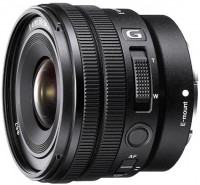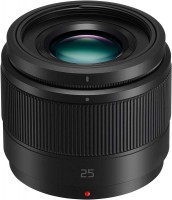Panasonic LUMIX G Leica DG Summilux II 25mm f/1.4 Lens with MFT Mount H-XA
 |
Buy Panasonic LUMIX G Leica DG Summilux II 25mm f/1.4 Lens with MFT Mount H-XA
When you make a purchase through links on our site, we may earn an affiliate commission.
Panasonic Lumix G Leica DG Summilux Lens H-XA025 | $597.99 | ||||
Panasonic LUMIX G Leica DG Summilux II 25mm f/1.4 Lens with MFT Mount H-XA | $599.99 | ||||
Panasonic Leica DG SUMMILUX 25mm/F14 II ASPH H-XA025 | $597.99 | ||||
Panasonic LUMIX G Leica DG Summilux II 25mm f/1.4 Aspherical Lens for MFT | $597.99 | ||||
No matter where you find your subjects - indoors, outdoors or at night - the soft-focusing effect of the Lumix G Leica DG Summilux high-speed lens turns any scene into an evocative image. It's the lens to have for nature and wildlife imaging, as well as spur-of-the moment everyday settings and while travelling.An improvement from the original LEICA DG SUMMILUX lens that became a must-have for any LUMIX G series mirrorless Micro Four Thirds photographer due to its clean optical sharpness and the unique soft-focusing background effect it can generate, now with a rugged dust and splash*-resistant design. The F1.4 aperture provides for super bright light gathering under difficult low light conditions while the Panasonic Nano Surface Coating nearly eliminates common ghosting and flaring that can accompany wide open aperture photography.Supporting versatile use with its 50mm (35mm camera equivalent) focal length, the LEICA DG SUMMILUX 25mm / F1.4 II ASPH. features stunningly high resolution and a descriptive performance from the center to the corners of the image despite its large aperture. It provides a smooth defocus for a beautiful bokeh effect that makes pictures even more impressive.The lens system comprising 9 elements in 7 groups uses 2 aspherical lenses and 1 UHR (Ultra High Refractive) index lens. The UHR index lens and glass mold aspherical lenses achieve uniform description from the center to the corners. Panasonic Nano Surface Coating is also applied to minimize ghosts and flare. Clearing the stringent standard to be certified with the name of world-renowned LEICA, exceptional high image quality is guaranteed.Incorporating an inner focus drive system and stepping motor, the new LEICA DG SUMMILUX 25mm / F1.4 II ASPH. is capable of smooth, silent operation to work with the camera’s high-speed, high-precision contrast AF system for both photo and video recording. It is also compatible with the sensor drive at max. 240 fps to take maximum advantage of cameras with high-speed AF.FeaturesLEICA DG QUALITY – LEICA DG Mirrorless Micro Four Thirds lenses provide the ultimate in optical quality and performance. LEICA DG Lenses meet the strict quality standards set by Leica Camera AG.F1.4 APERTURE - High-speed F1.4 LEICA DG SUMMILUX lens with outstanding image rendering and exquisite soft-focusing effect.RUGGED DESIGN – Dust and splash*-resistant design withstands heavy field use under harsh conditions for high mobilityCOATED OPTICS - Nano Surface Coating by Panasonic ends unwanted ghosting and flaring.FILTER THREAD – For greater creative control this lens offers a 46mm thread mount for polarizer and other options lens filters.NOTE: *Dust and Splash Resistant does not guarantee that damage will not occur if this lens is subjected to direct contact with dust and water.SpecificationsLens Construction: 9 elements in 7 groups (2 aspherical lenses, 1 UHR lens)Nano Surface Coating: YesMount: Micro Four Thirds mountOptical Image
Product description is based on database from online stores. Be sure to verify all information directly with seller before purchasing.

What is the aperture of optics and what does it affect?Aperture, aperture, maximum relative aperture - in simple words about the main thing

How does autofocus work?When it comes to focusing on sharpness when taking photos and videos, automation can be fully relied on
How to place an order?How to add store?
Remember that online store is responsible for accuracy of information about price, warranty and delivery!
We recommendCompare using chart →










































